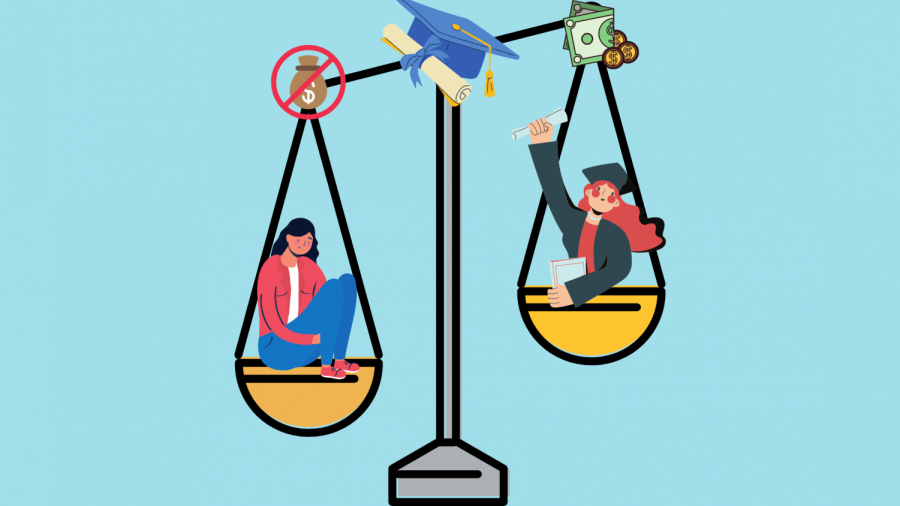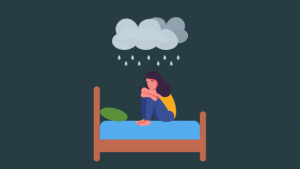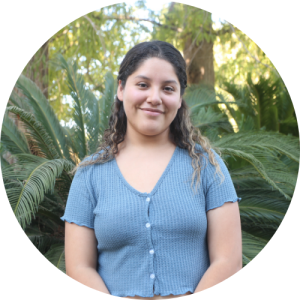OPINION: Low-income students are the most disadvantaged in online learning
The pandemic is deepening the educational gap
Financial barriers put low-income students at more of a disadvantage than those with a higher income during COVID-19. Graphic made in Canva.
September 24, 2020
Only eight months ago, amid the rise of COVID-19 cases in the U.S., schools across the country scrambled to get their students online in order to lower their exposure to the virus.
Here we are, what feels like centuries from those chaotic days in March, and distance learning has done nothing but disadvantage those with limited resources that are required for online schooling.
Cute and overly motivational articles have come out on blogs, newspapers and in our college emails with “tips to be successful in online school,” but none of these articles or organizations take into consideration that their attempt to be helpful is actually discouraging to a lot of people.
These articles tell students to “create a quiet work space” without realizing that a lot of students’ quiet work spaces were their college campuses and libraries. With campuses limiting their access to certain spaces like libraries or designated study areas and prohibiting students from using facilities they pay for with their tuition, most low-income students are forced to do their studying and online classes from home.
The Hechinger Report, which focuses on reporting stories about education, told the struggle of low-income college students who were living at home with their families, and how they had to not only manage their own schooling, but that of their siblings as well. These students shared the frustrations of being in large family households in tight living arrangements, ultimately making it hard to focus on their classes.
Imagine having to juggle four or more college courses while also trying to get your much younger and less focused siblings to do their own work online every single day for the next school year. There is no such thing as a “quiet work space” for them.
But let’s say these students do find a place to work peacefully. What about the requirement of having a reliable internet source?
48% of low-income families were reported to have no broadband, also referred to as high-speed Internet access, subscriptions in their home, and 44% said the reasoning was due to financial barriers.
RELATED: KYLIEBYTES: What can we do about the digital divide?
Low-income students are some of the hardest working people because they know their higher education is a privilege, but something as simple yet vastly complicated as not having reliable internet access could put them at a huge disadvantage compared to students whose families can afford internet.
Yes, there are campuses like Sacramento State that have made the internet accessible in its parking garage structures, but truly how focused could you be in a cramped car as the end-of-summer heat hits you like a bus?
On top of schoolwork, many low-income students are also forced to work part or full-time to help not only pay for college, but also as an additional income for their families.
26% of low-income learners in the U.S. are working full-time jobs, compared to the 22% of higher-income students. Those who come from high-income families tend to work for their own personal hobbies and lifestyle, while low-income students are working to make ends meet.
As someone who goes from online school four days a week to working over 20 hours on the weekend, I can say it’s extremely tiring and sometimes drastically affects my school work. Coming home from being on my feet all day and going straight into finishing up homework is mentally draining, but I have no other choice. By working, I take the financial burden off my parents to pay for extra expenses, like gas or rent, and give them the ability to worry about other bills that have surfaced over the course of COVID-19.
As much as I would love to lower my hours or stop working completely, my parents have done everything in their power, financially, to support my sister and I throughout our higher ed journey — the least I could do is take one thing off their shoulders.
All of these factors put on an added weight, mentally and emotionally.
With 41.6% of students reporting anxiety as their main concern in college, low-income individuals are already more likely to develop long time mental disorders, like depression and suicidal thoughts. Also, because therapy or counseling services are not always covered in health insurance plans, these individuals are less likely to reach out for help, worsening their mental health overall.
College students are already at high risk of developing mental illnesses because of the stress we endure with trying to figure out what we want to do with our lives in only four short years — add outside financial stressors that most students have no control over, and it becomes harder to see the positives in continuing your education.
I’m not saying that higher-income students aren’t experiencing struggles during this online transition, but us low-income students are at a much bigger disadvantage.
Low-income graduation rates are as low as 11% for those who graduate with a bachelor’s degree, whereas higher-income students graduate with rates as high as 58%. Of the Black and Hispanic students, who make up the majority races in low-income communities, only 14% and 11% respectively hold bachelor’s degrees compared to 24% of white people.
The odds are already stacked against us, now they’re asking us to jump through even more hoops to get our well-deserved education. It’s ridiculous.
As colleges and universities across the country start to begin the very early stages of transitioning the rest of the academic school year online, they need to start implementing solid plans to help students who already walked in with hardships that are now doubled by this pandemic. We have to come together to ensure that all students are on similar playing fields.
If nothing is done now and the pandemic runs its course longer than anticipated, we run the risk of deepening the educational divide that has burdened low-income communities for decades, and there’s no telling how we’ll recover from that.







































































































































Maya • Dec 10, 2020 at 7:13 pm
love it totally agree